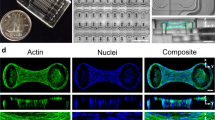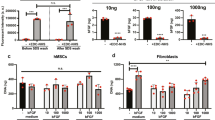Abstract
We show that the appropriate combinations of mechanical stimuli and polymeric scaffolds can enhance the mechanical properties of engineered tissues. The mechanical properties of tissues engineered from cells and polymer scaffolds are significantly lower than the native tissues they replace. We hypothesized that application of mechanical stimuli to engineered tissues would alter their mechanical properties. Smooth muscle tissue was engineered on two different polymeric scaffolds and subjected to cyclic mechanical strain. Short-term application of strain increased proliferation of smooth muscle cells (SMCs) and expression of collagen and elastin, but only when SMCs were adherent to specific scaffolds. Long-term application of cyclic strain upregulated elastin and collagen gene expression and led to increased organization in tissues. This resulted in more than an order of magnitude increase in the mechanical properties of the tissues.
This is a preview of subscription content, access via your institution
Access options
Subscribe to this journal
Receive 12 print issues and online access
$209.00 per year
only $17.42 per issue
Buy this article
- Purchase on Springer Link
- Instant access to full article PDF
Prices may be subject to local taxes which are calculated during checkout






Similar content being viewed by others
References
Langer, R. & Vacanti, J.P. Tissue engineering. Science 260, 920–926 (1993).
Fung, Y.C. Biomechanics: motion, flow, stress and growth. (Springer, New York; 1990).
Birukov, K.G. et al. Stretch affects phenotype and proliferation of vascular smooth muscle cells. Mol. Cell. Biochem. 144, 131–139 (1995).
Costa, K.A., Sumpio, B.E. & Cerreta, J.M. Increased elastin synthesis by cultured bovine aortic smooth muscle cells subjected to repetitive mechanical stretching. FASEB J. 5, A1609 (1991).
Kulik, T.J. & Alvarado, S.P. Effect of stretch on growth and collagen synthesis in cultured rat and lamb pulmonary arterial smooth muscle cells. J. Cell. Physiol. 157, 615–624 (1993).
Leung, D.Y.M., Glagov, S. & Mathews, M.B. Cyclic stretching stimulates synthesis of matrix components by arterial smooth muscle cells in vitro. Science 191, 475–478 (1976).
Leung, D.Y.M., Glagov, S. & Mathews, M.B. A new in vitro system for studying cell response to mechanical stimulation. Exp. Cell Res. 109, 285–298 (1977).
Mills, I., Cohen, C.R. & Sumpio, B.E. in Hemodynamic forces and vascular cell biology (ed. Sumpio, B.E.) 66–89 (R.G. Landes, Austin, TX; 1993).
Predel, H-G. et al. Implications of pulsatile stretch on growth of saphenous vein and mammary artery smooth muscle. Lancet 340, 878–879 (1992).
Sumpio, B.E. & Banes, A.J. Response of porcine aortic smooth muscle cells to cyclic tensional deformation in culture. J. Surg. Res. 44, 696–701 (1988).
Wilson, E., Mai, Q., Sudhir, K., Weiss, R.H. & Ives, H.E. Mechanical strain induces growth of vascular smooth muscle cells via autocrine action of PDGF. J. Cell Biol. 123, 741–747 (1993).
Wilson, E., Sudhir, K. & Ives, H. E. Mechanical strain of rat vascular smooth muscle cells is sensed by specific extracellular matrix/integrin interactions. J. Clin. Invest. 96, 2364–2372 (1995).
Reusch, P., Wagdy, H., Reusch, R., Wilson, E. & Ives, H.E. Mechanical strain increases smooth muscle and decreases nonmuscle myosin expression in rat vascular smooth muscle cells. Circ. Res. 79, 1046–1053 (1996).
Buck, R.C. Behaviour of vascular smooth muscle cells during repeated stretching of the substratum in vitro. Atherosclerosis 46, 217–223 (1983).
Kanda, K. & Matsuda, T. Behavior of arterial wall cells cultured on periodically stretched substrates. Cell Transplant. 2, 475–484 (1993).
Mills, I.R.A. et al. Strain activation of bovine aortic smooth muscle cell proliferation and alignment: study of strain dependency and the role of protein kinase A and C signaling pathways. J. Cell. Physiol. 170, 228–234 (1997).
Tranquillo, R.T., Girton, T.S., Bromberek, B.A., Triebes, T.G. & Mooradian, D.L. Magnetically orientated tissue-equivalent tubes: application to a circumferentially orientated media-equivalent. Biomaterials 17, 349–357 (1996).
Hirai, J. & Matsuda, T. Venous reconstruction using hybrid vascular tissue composed of vascular cells and collagen: tissue regeneration process. Cell Transplant. 5, 93–105 (1996).
Weinberg, C.B. & Bell, E. A blood vessel model constructed from collagen and cultured vascular cells. Science 231, 397–400 (1986).
Ziegler, T. & Nerem, R.M. Tissue engineering a blood vessel: regulation of vascular biology by mechanical stresses. J. Cell. Biochem. 56, 204–209 (1994).
Kim, B.-S., Putnam, A.J., Kulik, T.J. & Mooney, D.J. Optimizing seeding and culture methods to engineer smooth muscle tissue on biodegradable polymer matrices. Biotechnol. Bioeng. 57, 46–54 (1998).
Kim, B.-S. & Mooney D.J. Engineering smooth muscle tissue with a predefined structure. J. Biomed. Mater. Res. 41, 322–332 (1998).
Hume, W.R. Proline and thymidine uptake in rabbit ear artery segments in vitro increased by chronic tangential load. Hypertension 2, 738–743 (1980).
Kolpakov, V., Rekhter, M.D., Gordon, D., Wang, W.H. & Kulik, T.J. Effect of mechanical forces on growth and matrix protein synthesis in the in vitro pulmonary artery. Circ. Res. 77, 823–831 (1995).
Niklason, L.E. et al. Functional arteries grown in vitro. Science 284, 489–493 (1999).
van der Lei, B., Nieuwenhuis, P., Molenaar, I. & Wildevuur, C.R.H. Long-term biologic fate of neoarteries regenerated in microporous, compliant, biodegradable, small-caliber vascular grafts in rats. Surgery 101, 459–467 (1987).
Kanda, K. & Matsuda, T. Mechanical stress-induced orientation and ultrastructural changes of smooth muscle cells cultured in three-dimensional collagen lattices. Cell Transplant. 3, 481–492 (1994).
Park, JB. & Lakes, R.S. Biomaterials: an introduction. 2nd edn. (Plenum, New York; 1992).
Choi, R.S., Kim, B.S., Mooney, D.J. & Vacanti, J.P. Expression of brush border enzymes and formation of basement membrane from transplanted intestinal epithelial organoid units using biodegradable tubular scaffolds. J. Pediatr. Surg., 33, 991–997 (1998).
Oberpinning, F., Meng, J., Yoo, J. & Atala, A. De novo reconstitution of a functional mammalian urinary bladder by tissue engineering. Nat. Biotechnol. 17, 149–155 (1999).
Rothman, A. et al. Development and characterization of a cloned rat pulmonary arterial smooth muscle cell line that maintains differentiated properties through multiple subcultures. Circulation 86, 1977–1986 (1992).
Ingber, D. Fibronectin controls capillary endothelial growth by modulating cell shape. Proc. Natl. Acad. Sci. USA 87, 3579–3583 (1990).
Yin, W. et al. Isolation of a novel latent transforming growth factor-b binding protein gene (LTBP-3). J. Biol. Chem. 270, 10147–10160 (1995).
Chu, M.L., Myers, J.C., Bernard, M.P., Ding, J.F. & Ramirez, F. Cloning and characterization of five overlapping cDNAs specific for the human pro alpha 1(I) collagen chain. Nucleic Acids Res. 10, 5925–5934 (1982).
Stanislawski, L., De Nechaud, B., Christel P. Plasma protein adsorption to artificial ligament fibers. J. Biomed. Mater. Res. 29, 315–23 (1995).
Acknowledgements
This work was supported by the National Science Foundation (BES-9501376) and a fellowship to J.N. from the Organogenesis Training Grant (NIH 5T32 HD07505-02). We are grateful to Elizabeth Smiley for her help with northern blot analysis.
Author information
Authors and Affiliations
Corresponding author
Rights and permissions
About this article
Cite this article
Kim, BS., Nikolovski, J., Bonadio, J. et al. Cyclic mechanical strain regulates the development of engineered smooth muscle tissue. Nat Biotechnol 17, 979–983 (1999). https://doi.org/10.1038/13671
Received:
Accepted:
Issue Date:
DOI: https://doi.org/10.1038/13671
This article is cited by
-
Tissue engineering of the gastrointestinal tract: the historic path to translation
Journal of Biological Engineering (2022)
-
Physiologically relevant platform for an advanced in vitro model of the vascular wall: focus on in situ fabrication and mechanical maturation
In vitro models (2022)
-
Human iPS Cell-derived Tissue Engineered Vascular Graft: Recent Advances and Future Directions
Stem Cell Reviews and Reports (2021)
-
A nonlinear elastic description of cell preferential orientations over a stretched substrate
Biomechanics and Modeling in Mechanobiology (2021)
-
The stiffness of living tissues and its implications for tissue engineering
Nature Reviews Materials (2020)



